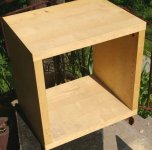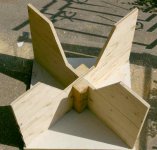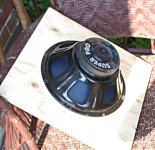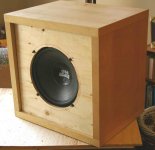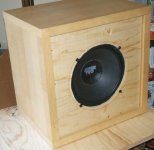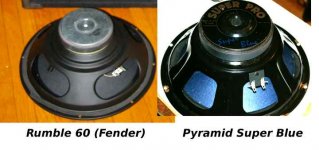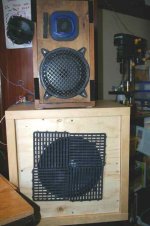Well, this thread/project is a spin-off from my guitar/bass-guitar cabinet project in "Full Range" section.
As some may know,
when rummaging around in my garage,
I found a car subwoofer box left by a previous tenant.
Initially I pulled the 12" drivers,
and they were kinda beat up, surround had come off,
and looks like the dust-caps were deliberately pushed in.
The surrounds had been repaired with a glue-gun unsuccessfully,
so I scraped all that off and re-glued with a kind of 'super-glue'.
I picked up new gaskets at the Speaker Shop,
and I was on my way to restoring two 12" subwoofers!
Here was my post from there:
These speakers seemed to be worth fixing up,
although I don't have any budget for full re-coning.
As some may know,
when rummaging around in my garage,
I found a car subwoofer box left by a previous tenant.
Initially I pulled the 12" drivers,
and they were kinda beat up, surround had come off,
and looks like the dust-caps were deliberately pushed in.
The surrounds had been repaired with a glue-gun unsuccessfully,
so I scraped all that off and re-glued with a kind of 'super-glue'.
I picked up new gaskets at the Speaker Shop,
and I was on my way to restoring two 12" subwoofers!
Here was my post from there:
...But still:
An externally hosted image should be here but it was not working when we last tested it.
Here are the original specs:
PW 1258-US (12" 8 ohm version)
They sell both at Parts Express for about $49.75
*
Power handling: 300 watts RMS *
VCdia: 2" *
Znom: 8 ohms *
Frequency response: 40-3,000 Hz *
Fs: 26.29 Hz *
SPL: 90 dB 1W/1m *
Vas: 7.54 cu. ft. *
Qms: 9.94 *
Qes: .36 *
Qts: .35 *
Xmax: 4.6mm *
Net weight: 9-1/8 lbs.
Suitable for woofer or subwoofer duty.
Here is the blurb for the 4 ohm version:
The Super Blue Series features a heavy duty blue
polymer laminate paper cone with a butyl rubber surround
for long life and durability.
The combination of 2" Kapton voice coil,
extended bump plate and vented magnet structure
allows for high power handling capability and high SPLs!
Ideal for all high performance car audio applications.
Made in the U.S.A.
Specifications: *
Power handling: 250 watts RMS/355 watts max. *
Voice coil diameter: 2" *
Impedance: 4 ohms *
Frequency response: 30-1,800 Hz *
Magnet weight: 50 oz. *
Fs: 27 Hz *
SPL: 94 dB 1W/1m *
Vas: 8.11cu. ft. *
Qms: 8.74 *
Qes: .31 *
Qts: .30 *
Xmax: 4.6mm *
Net weight: 10 lbs. *
Manufacturer model number: PW1254-US *
Dimensions: Overall Diameter: 12-1/8",
Cutout Diameter: 11",
Mounting Depth: 5-1/4",
Magnet Diameter: 5-1/4",
Magnet Height: 1-3/4".
So, all I have to do is figure out how to re-do the surrounds properly, and bingo,
I think I have some bass speakers to try out in the cab!
Hmmm....looking twice at the construction of the surrounds,
I think this is a good argument for NOT front-mounting a bass speaker.
Had they been mounted to the panel from the back, the surrounds would have been pinned,
between the cardboard grommet, and the metal frame.
and probably wouldn't have torn off.
(possibly outdoor use was a contributing factor too,
because there appears an undue amount of rust on the metal cage where the glue was.
Rain?)
---------
These speakers seemed to be worth fixing up,
although I don't have any budget for full re-coning.
Now comes Part 2:
PW 1258-US (12" 8 ohm version)
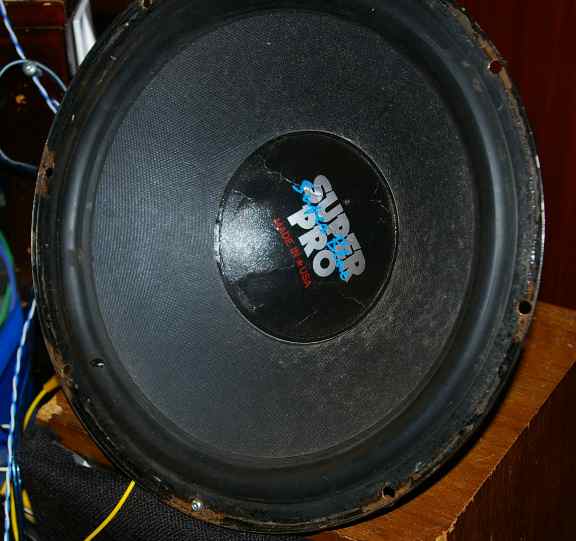
I repaired the speakers (I'll post some pics in a sec).
I started by sawing the original cabinet (it had a divider) in half,
and making a subwoofer cab out of it.
This needed serious reinforcing, and stuffing,
but it seemed to work, although after plugging the port,
the cab is in fact too small for a 12" I think.
(I'll calculate the cubic feet in that cab in a moment).
Anyway, I wasn't satisfied with either the look or size/sound.
----------------------------------
Now comes the fun part.
I'm driving along looking for garbage as usual,
and low and behold,
someone has thrown out an end-table.
This is a modern type, with Ikea-type locking bolts and glued parts,
and pegholes for shelves.
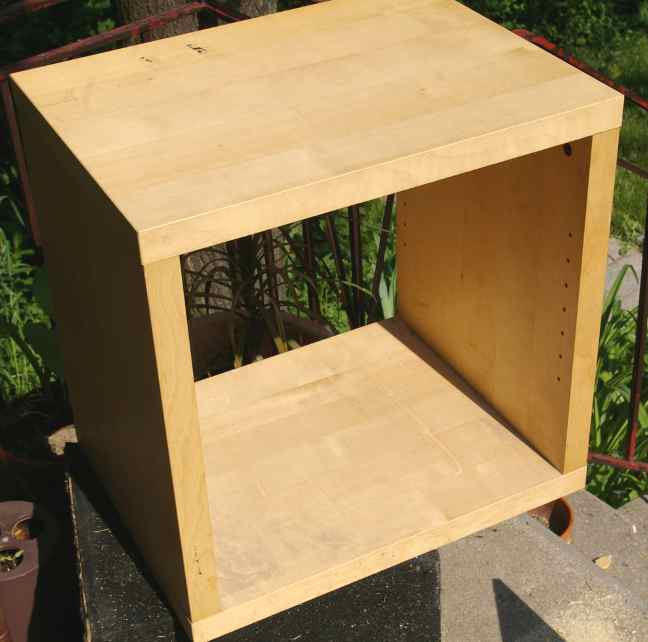
But most important of all, to make the wood look big and thick,
they've of course cheated: Its hollow!.
Its constructed the way they make modern doors, and airplane wings:
With secret struts and cross-braces to give very thin plywood the same stiffness as solid board.
...Actually BETTER. For sound, and other purposes,
these panels are actually stiffer than plywood twice the weight and thickness, i.e., 3/8" or 1/2" ply!
But they are half as heavy too! because they are mostly air!
If you think this wouldn't make a good speaker-cabinet wall,
think again, because modern speaker-makers are using the same techniques!
Even for bass cabinets!
So, Since I can't re-size or refinish the thing if I were to break it apart,
I resorted to measuring the inside volume: 2.5 cubic feet!
Just about perfect for one 12" woof or two 10" woofers!
But it had no back or front, so I had to cobble my own.
While doing that, I used the same reinforcement strategy as in my own modifed Marshall Cabinet:
and to give something to screw to through the back plate.
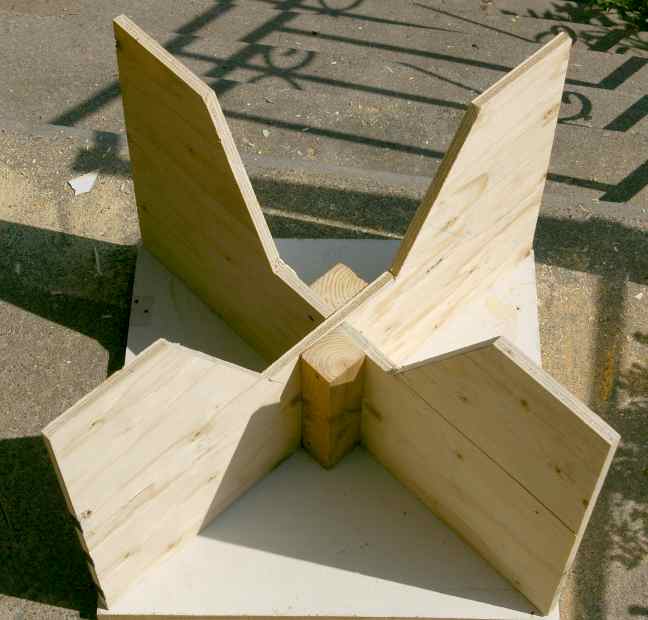
I only used 5/8" ply for the front, but 1" ply for the back, because hey,
the front is mostly speaker anyway, and all the edges are going to sit on an inner rim/shelf,
which I will screw the front-plate down to.
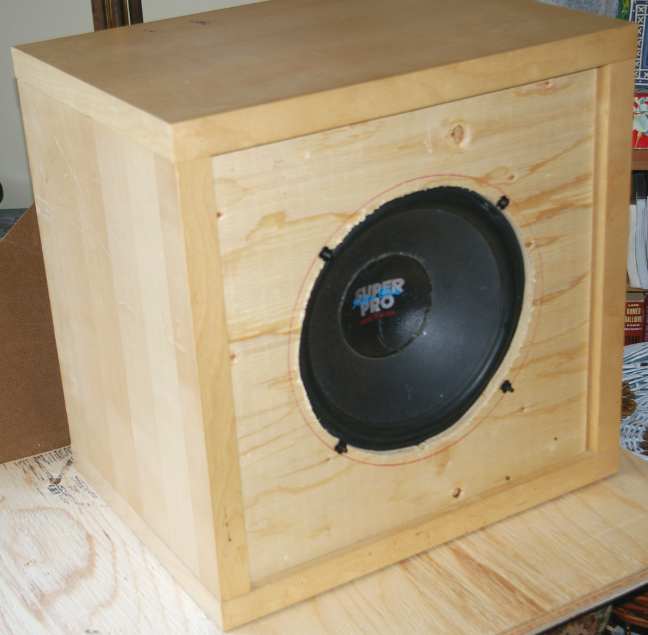
Not bad for a half-day's monkeying around!
I'll also stuff it and maybe dampen the side panels,
and add a front screen for looks and protection.
PW 1258-US (12" 8 ohm version)

I repaired the speakers (I'll post some pics in a sec).
I started by sawing the original cabinet (it had a divider) in half,
and making a subwoofer cab out of it.
This needed serious reinforcing, and stuffing,
but it seemed to work, although after plugging the port,
the cab is in fact too small for a 12" I think.
(I'll calculate the cubic feet in that cab in a moment).
Anyway, I wasn't satisfied with either the look or size/sound.
----------------------------------
Now comes the fun part.
I'm driving along looking for garbage as usual,
and low and behold,
someone has thrown out an end-table.
This is a modern type, with Ikea-type locking bolts and glued parts,
and pegholes for shelves.

But most important of all, to make the wood look big and thick,
they've of course cheated: Its hollow!.
Its constructed the way they make modern doors, and airplane wings:
With secret struts and cross-braces to give very thin plywood the same stiffness as solid board.
...Actually BETTER. For sound, and other purposes,
these panels are actually stiffer than plywood twice the weight and thickness, i.e., 3/8" or 1/2" ply!
But they are half as heavy too! because they are mostly air!
If you think this wouldn't make a good speaker-cabinet wall,
think again, because modern speaker-makers are using the same techniques!
Even for bass cabinets!
So, Since I can't re-size or refinish the thing if I were to break it apart,
I resorted to measuring the inside volume: 2.5 cubic feet!
Just about perfect for one 12" woof or two 10" woofers!
But it had no back or front, so I had to cobble my own.
While doing that, I used the same reinforcement strategy as in my own modifed Marshall Cabinet:
Notice the 2x2" blocks for reinforcement,I came up with a real strong front/back support scheme:
The St.Andrews cross-diagonals.
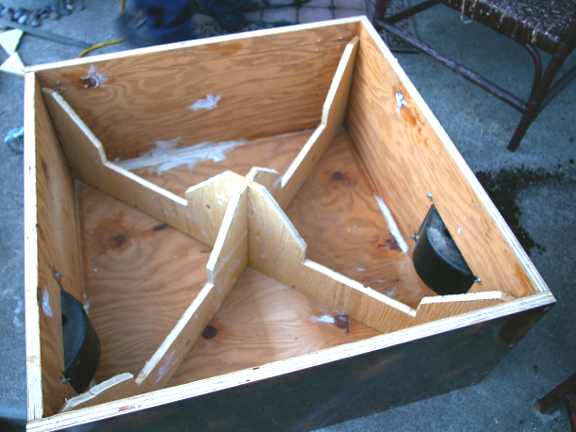
This is like the Greek-cross idea, but actually better I think,
because it doesn't divide up the back resonating drum-head
into smaller drumheads.
Instead, the triangular shapes quickly dampen and kill resonances
and turn standing waves into quiet heat.
Also, the cross supports the front panel in five places, including
the front center, the most important zone. I am also toying with
adding 2x4 or 2x2 struts at 12 o-clock, 3 oclock, 6 oclock and 9 oclock,
about half-way from center, to further support the front-panel at its weakest points.
and to give something to screw to through the back plate.

I only used 5/8" ply for the front, but 1" ply for the back, because hey,
the front is mostly speaker anyway, and all the edges are going to sit on an inner rim/shelf,
which I will screw the front-plate down to.

Not bad for a half-day's monkeying around!
I'll also stuff it and maybe dampen the side panels,
and add a front screen for looks and protection.
Attachments
Last edited:
How does it sound?
Have you tried playing your bass through it?
Chris
No, this isn't for bass: Too small, too low power.
It will be a subwoofer for my near-field Focals.
For info, this cab has the following internal / external dimensions:
Internal: 17.5" wide x 17.75" tall x 14.25" (effective) deep. = 2.5 cu ft.
back panel - 1" ply
front panel - 5/8" ply
external: 20.25" wide x 20.5" tall x 15.74" deep.
Waiting for glue to dry.
Also, here's an amazingly convenient thing.
Whereas with solid walls you have to brace from the inside (for looks),
taking up precious cabinet volume,
here you can drill into the walls from the inside,
and fill the cavities with foam insulation.
The very effectively stiffens all the sides even further,
without adding any significant weight to the enclosure,
OR decreasing the effective cabinet volume at all!
Last edited:
Hi,
FWIW your bracing scheme is never used in speakers I've seen because
it has no effect on the top / bottom / side panels.
Well, here is the whole point:
With commercially manufactured offerings,
it comes down to cost.
Since sides have to be braced,
its cheaper for cabinet makers to brace using the St.George Cross,
rather than use the St.Andrews X, and still have to brace sides, top and bottom.
But DIYers are not limited by cost in the same way,
because they are only doing one-offs, and only spending the money/time/effort ONCE.
Cheaper does not equal Better.
See previous post also, above.Rotated 45 degrees
its far better, adding offsets to avoid coincident panels even better.
With these new-style fabricated walls,
you can stiffen sides very effectively even more than they are,
without struts, and without losing any cabinet volume.
Ergo, The St.Andrews X is now the best option.
keep in mind that the one thing all rectangular cabs face
is Standing Waves.
Triangular compartments kill them dead.
X-design wins.
Last edited:
There are no standing waves in a subwoofer box (unless it's huge, think refrigerator sized). Even with the internal bracing you still have four panels that have the same open panel dimension, meaning they will all have the same resonance. Stiffness isn't everything.
Last edited:
There are no standing waves in a subwoofer box
(unless it's huge, think refrigerator sized).
Even with the internal bracing you still have four panels
that have the same open panel dimension,
meaning they will all have the same resonance.
Stiffness isn't everything.
Your point about the resonance is valid here, with top, bottom and sides virtually the same size.
Not the one about no standing waves.
I always run a relatively small hardwood diagonal brace across rectangular walls inside a cab;
this brace doesn't have to be much in size or volume to kill a rectangular plate vibration.
In my living-room scenario, the bottom plate will be strongly muted by the floor,
and the top weighed down by the mids/tweeters.
Don't forget that all 2-dimensional harmonic vibration patterns are non-integrals, that is, not whole-number frequency multiples,
and so like a drum head quickly die.
The key is to mute the fundamental and the 1st few harmonics
of the standing waves themselves,
which are more like a 1-dimensional air-column type of vibration, with musical harmonics.
Finally, the X-cross shape is the whole point.
It kills all standing waves between parallel sides.
The only issue left is the front/back standing wave.
This is broken up effectively by the central core-block (whatever orientation),
and of course the stuffing.
Again you can't have it both ways.
The wavelengths on the panels (vibrating plates) are
as small as the distances between parallel panels.
So the frequency-range of both is about the same here!
If the panels can vibrate, then so can standing waves in the chamber, and vise versa.
You seem to be claiming that the panels can vibrate at frequencies lower than the cavity-waves.
That is impossible.
That might be true for heavy steel plates or thick dense but springy hardwood,
but these panels have no weight, and so their resonances will be quite high relatively.
Last edited:
Well, here is the whole point:
With commercially manufactured offerings,
it comes down to cost.
Since sides have to be braced,
its cheaper for cabinet makers to brace using the St.George Cross,
rather than use the St.Andrews X, and still have to brace sides, top and bottom.
But DIYers are not limited by cost in the same way,
because they are only doing one-offs, and only spending the money/time/effort ONCE.
Cheaper does not equal Better.
See previous post also, above.
With these new-style fabricated walls,
you can stiffen sides very effectively even more than they are,
without struts, and without losing any cabinet volume.
Ergo, The St.Andrews X is now the best option.
keep in mind that the one thing all rectangular cabs face
is Standing Waves.
Triangular compartments kill them dead.
X-design wins.
Hi,
You've done it so it must be better. It isn't, and quite frankly i don't
care for your nonsense arguments. Triangular compartments or
rooms don't kill resonances at all. Certainly in your case front to
back, and by simply adding a mirror as the side wall all your
compartments are effectively square and will resonate badly.
I can't remember offhand what the transform is, but anything
resembling a repeating tiling pattern will have resonances.
rgds, sreten.
Last edited:
If the crossover frequency was mentioned in this thread, I missed it. I see where the specs say this driver goes to 3000Hz, but as a subwoofer I would think it should be rolled off above 60 to 100Hz, which should keep it from activating any resonances or at least reducing their level.
Yes this is quite right:If the crossover frequency was mentioned in this thread, I missed it. I see where the specs say this driver goes to 3000Hz, but as a subwoofer I would think it should be rolled off above 60 to 100Hz, which should keep it from activating any resonances or at least reducing their level.
My plan is to use it to finish the bottom end of my near-fields,
which are a Focal midrange and Focal tweeter (stereo).
I was thinking of crossing over around 120 Hz,
but I could see going as high as 200 Hz.
Still, the box should be safe from most resonance problems,
with most of the power going to the mid.
If this works, I'll look for another suitable end-table at Ikea,
and make a matching pair (left and right).
Its a fun idea to think of trying it out for a bass guitar,
but I really can't see pumping it with more than 50-70 watts,
and that might be pushing it too far.
Even then, I think I'd choose to add a high-power tweeter,
and a crossover, maybe down as low as 1k anyway.
So there will still be few serious resonances,
and hopefully none at all on the bass fretboard range.
As for playing bass through this,
It has to be better than the rinky-dink speaker that came in the Rumble 60.
I may just hook it up to that amp to see how different the sound is.
Already here I will have doubled the cubic feet at 2.5 ft3,12" underpowered "Fender Special" speaker, small magnet (prob.50w)
Bass Reflex Cabinet w. slot along bottom:
9" deep X 15 3/8" wide x 15 1/4" high (16 3/4" at back) interior box,
= 2140 cubic inches (1.24 ft³, .035 m³ )
with port/slot = 3/4" high x 16" wide, (12 Sq. In.)
and about 7" deep. (84 cubic in. in volume).

As it is, the cabinet has a horrible "honk/peak" with the low E string,
and another one about an octave higher. Very uneven bass response,
the four-knob EQ doesn't fix this,- not even in the ballpark.
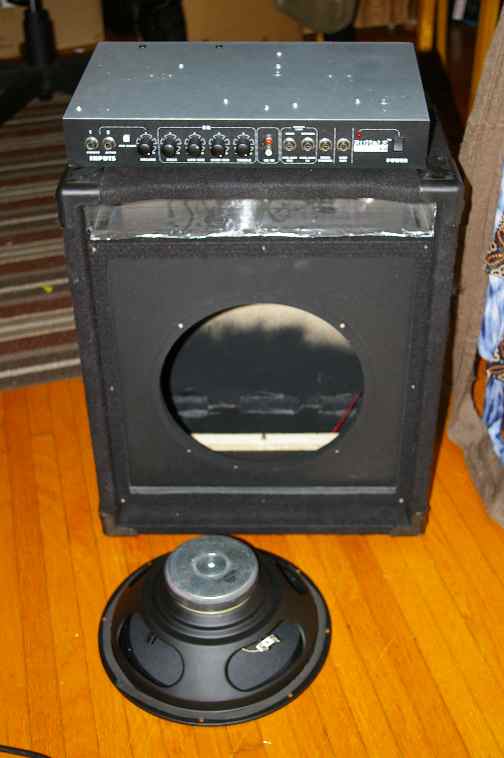
and the Pro speaker must be 4 times the watts of the Fender.
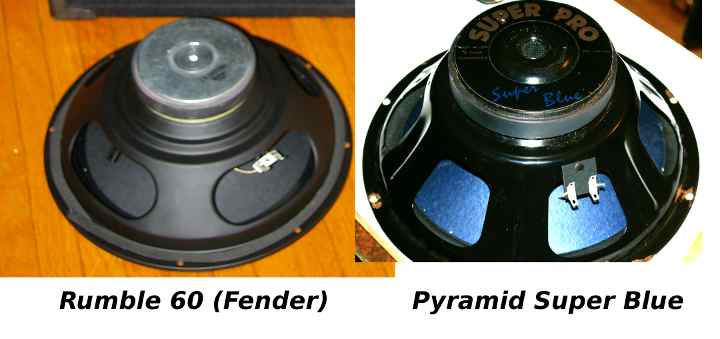
The only issue is the soft rubber surround vs. the reinforced cloth accordion surround of the Fender.
There will probably be less midrange presence.
I could also try porting the cabinet.
Any ideas on that?
Attachments
Last edited:
Stiffness isn't everything.
"...That's what she said..."
Just finished Test 1:How does it sound?
Have you tried playing your bass through it?
Chris
As subwoofer with Focals:
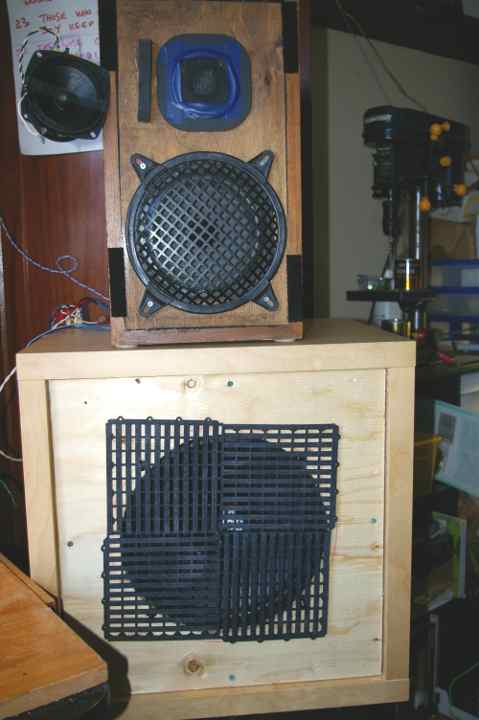
FABULOUS!
List of cuts:
Emma Shaplin Carmine Meo - Bass is all there, completes the background vocals properly.
My Love is a Mountainside - Diana Krall - The Bass is two feet away, and I can feel his fingers. The Hall reverb is breathtaking: Close your eyes and imagine the large expanse being filled with Diana's sweet voice. I was missing the bass element in reverb, and had forgotten how its supposed to be!
Batonga - Angelique Kidjo Powerful clean bass - The Xylophone jumps out and vibrates! Kick drum is in the room.
Chicago Transit Authority - I'm a Man - drums jump out now, organ is sweet. Kick drum is two feet away. Guitar sounds authoritative. vocals sound better.
each drum in the solo now has a personality.
Peter Gabriel - Father - organ/synth carries the whole room along the river. Bass is dramatic, individual tracks are clear.
Santana - Singing Birds, Crying Beasts. - the rolling cymbal work has depth and expansion. The piano is clear and musical. Santana's guitar sounds the same. The percussion is delicate and delightful.
Deborah Cox - Be Good to Me - The synthesized Bass is Jaw-dropping and clear with full effects.
etc. etc.
I'm going to hunt down this piece of furniture and buy 3 more,
and turn them into sub-cabinets!!
Holy moly...the materials are awesome, (and apparently my design was more than adequate.)
The rebuilt speaker seems to be holding up fine for this function anyway...
Attachments
Last edited:
Nice recycling.
Looks like some of my experiments.
I would not waste any time on a car/home speaker for musical instruments cabinets. Most bass guitar speakers have a bit of "character" and can handle more abuse with the accordion surround.
MCM has some dirt cheap 12"s that would be better.
Looks like some of my experiments.
I would not waste any time on a car/home speaker for musical instruments cabinets. Most bass guitar speakers have a bit of "character" and can handle more abuse with the accordion surround.
MCM has some dirt cheap 12"s that would be better.
Looks like some of my experiments.
I would not waste any time on a car/home speaker for musical instruments cabinets. Most bass guitar speakers have a bit of "character" and can handle more abuse with the accordion surround.
MCM has some dirt cheap 12"s that would be better.
Yes, I noted the MCMs in my Marshall Cabinet thread.
The point here was, basically:
(1) I got the furniture free, pre-finished, and only needing a back and front, and some reinforcing.
(2) I got the bass sub-woofers free, abandoned in the garage by a previous tenant.
(3) The purpose for this cab is as a sub-woofer for my stereo.
The success of the project is in part as a result of cost.
Others may find suitable furniture free or unused,
and may be encouraged to make a cabinet from it.
My total cost was:
(1) Some 1/2" plywood scrap I had laying around.
(2) a few hours of sawing, gluing and screwing.
(3) a few dollars for screws and glue.
I think its a go.
- Status
- This old topic is closed. If you want to reopen this topic, contact a moderator using the "Report Post" button.
- Home
- Loudspeakers
- Subwoofers
- Budget Subwoofer Project
